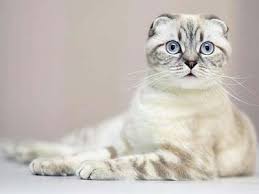Introduction
The Scottish Fold cat, known for its distinctive folded ears, has captivated cat enthusiasts worldwide. This breed’s unique appearance, coupled with its affectionate and adaptable nature, makes it a favorite among cat lovers. This guide provides a comprehensive overview of the Scottish Fold breed, covering its history, characteristics, care requirements, and common health issues.
History of the Scottish Fold
The Scottish Fold cat originated in Scotland in 1961 when a shepherd named William Ross discovered a white barn cat with folded ears. Named Susie, this unique cat became the foundation of the Scottish Fold breed. The breed’s development involved breeding Susie’s descendants with British Shorthairs and domestic cats, leading to the distinctive look we see today.
In the 1970s, the breed faced challenges in the UK due to concerns about ear disorders. However, Scottish Folds found a new home in the United States, where breeders continued to develop and refine the breed. By 1978, the Scottish Fold had achieved Championship status with the Cat Fanciers’ Association (CFA).
Physical Characteristics
Scottish Folds are medium-sized cats with a rounded appearance, accentuated by their folded ears, which fold forward and downward. This breed comes in both shorthaired and longhaired varieties, with the latter known as the Highland Fold or Scottish Fold Longhair, depending on the cat association.
Key Physical Traits:
- Ears: The signature folded ears are due to a dominant gene affecting the ear cartilage.
- Head: Rounded with large, expressive eyes.
- Body: Well-rounded and muscular.
- Coat: Dense and plush, available in various colors and patterns.
Personality and Behavior
Scottish Folds are known for their sweet, gentle, and playful nature. They are intelligent and adapt well to different environments and people, making them excellent companions.
Temperament Highlights:
- Affectionate: Bond closely with their primary caregiver but are friendly with others.
- Playful: Enjoy games like fetch and retain a playful demeanor into adulthood.
- Adaptable: Handle changes in their environment and routine well.
- Quiet: Soft-spoken and not overly vocal.
Health and Genetic Concerns
The gene responsible for the folded ears can also cause skeletal issues, such as congenital osteodystrophy, which affects bone development. Breeding two Folds can increase the risk of this condition, so responsible breeders pair Folds with straight-eared cats to minimize health problems.
Health Tips:
- Regular Checkups: Monitor for joint and bone issues.
- Ear Care: Clean ears regularly to prevent wax buildup and infections.
- Balanced Diet: Ensure a diet that supports overall health and joint care.
Grooming and Care
Scottish Folds require regular grooming to maintain their coat and overall health. Longhaired varieties need more frequent brushing to prevent matting.
Grooming Routine:
- Brushing: Weekly for shorthaired, more often for longhaired.
- Ear Cleaning: Regular cleaning to prevent infections.
- Dental Care: Routine dental hygiene to prevent periodontal disease.
- Nail Trimming: Regularly trim nails to prevent overgrowth.
Breeding and Genetics
Breeding Scottish Folds requires careful planning to avoid genetic health issues. Breeding a Fold to a straight-eared cat is recommended to reduce the risk of skeletal deformities. All Scottish Folds are born with straight ears, which start to fold around three weeks of age if they carry the gene.
Breeding Facts:
- Gene: Dominant gene causes ear folding.
- Fold-to-Fold Breeding: Increases health risks, avoided by responsible breeders.
- Kittens: Ear folds develop at three weeks, varying in tightness.
Popularity and Recognition
The Scottish Fold’s unique appearance and friendly nature have made it one of the top ten most popular cat breeds in the United States. The breed is recognized by various cat associations, each with specific standards and naming conventions.
Association Names:
- ACFA, AACE, UFO: Highland Fold.
- TICA, NCFA, ACA, CCA, CFA: Scottish Fold Longhair.
- CFF: Longhair Fold.
- Canada: Known as the Coupari.
Conclusion
The Scottish Fold cat is a charming and unique breed that brings joy to many households. Its distinctive folded ears, coupled with a gentle and affectionate nature, make it a beloved pet. Understanding the breed’s history, characteristics, and care requirements ensures that potential owners can provide a loving and healthy environment for these delightful cats.
For more information on the Scottish Fold and other cat breeds, visit Cat Place.
- ☆☆☆☆ Activity
- ☆☆☆☆☆☆☆ Playfulness
- ☆☆☆☆☆ Need for Attention
- ☆☆☆☆☆☆☆ Affection
- ☆☆ Need to Vocalize
- ☆☆☆☆☆☆☆ Docility
- ☆☆☆☆☆☆☆ Intelligence
- ☆☆☆☆☆☆☆ Independence
- ☆☆☆ Healthiness and Hardiness
- ☆☆☆☆☆ Grooming needs
- ☆☆☆☆☆☆ Good with children
- ☆☆☆☆☆☆ Good with other pets

